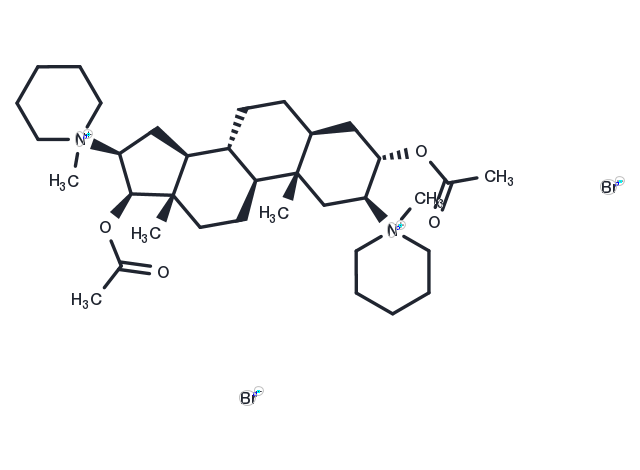Powder: -20°C for 3 years | In solvent: -80°C for 1 year


Pancuronium dibromide (Pavulon), a competitive AChR antagonist (IC50 = 5.5 nM), acts as a skeletal muscle relaxant. Pancuronium dibromide(Pancuronium bromide) blocking neuromuscular transmission is achieved by competing with acetylcholine for receptor sites on the motor end-plate.

| Pack Size | Availability | Price/USD | Quantity |
|---|---|---|---|
| 5 mg | In stock | $ 32.00 | |
| 10 mg | In stock | $ 50.00 | |
| 25 mg | In stock | $ 75.00 | |
| 50 mg | In stock | $ 117.00 | |
| 100 mg | In stock | $ 198.00 | |
| 200 mg | In stock | $ 247.00 | |
| 500 mg | In stock | $ 415.00 | |
| 1 mL * 10 mM (in DMSO) | In stock | $ 57.00 |



| Description | Pancuronium dibromide (Pavulon), a competitive AChR antagonist (IC50 = 5.5 nM), acts as a skeletal muscle relaxant. Pancuronium dibromide(Pancuronium bromide) blocking neuromuscular transmission is achieved by competing with acetylcholine for receptor sites on the motor end-plate. |
| Targets&IC50 | AChR:5.5 nm |
| In vitro | Pancuronium results in open channel block of embryonic-type nicotinic acetylcholine receptor channels after coapplication of blocker and acetylcholine, characterized by decrease of the time constant of current decay. Pancuronium also results in competitive block of embryonic-type nicotinic acetylcholine receptor channels. [1] Pancuronium increases heart rate, vecuronium and rocuronium produces positive inotropic effects, and vecuronium shortens refractoriness in isolated rat atria. [2] Pancuronium (0.5 mM) induces a complete fade of the tetanic contraction while leaving the twitch unaffected in the extensor digitorum longus muscle of the rat. Pancuronium decreases the amplitude and increases the tetanic rundown of trains of endplate potentials (e.p.ps) evoked in the frequency of 50 Hz in the extensor digitorum longus muscle of the rat.[3] |
| In vivo | Pancuronium decreases tidal volume (VT) and minute ventilation (VE) in high dosedogs by 82%. Pancuroniumdecreases tidal volume (VT) and minute ventilation (VE) in low dosedogs by 40% and 55%. [4] Pancuronium limitscerebralhyperemia during prolongedseizuresby attenuating increases inbloodpressure as a result of elimination of skeletal muscle activity in newborn pigs. [5] Pancuroniumresults in a significant difference with control is observed at gallamine concentrations ranging from 0.032-0.32 mM intrachealsmooth musclestrips fromguinea-pigs.[6] |
| Synonyms | Pancuronium bromide, Pavulon |
| Molecular Weight | 732.67 |
| Formula | C35H60Br2N2O4 |
| CAS No. | 15500-66-0 |
Powder: -20°C for 3 years | In solvent: -80°C for 1 year
H2O: 136.49mM
DMSO: 136.5 mM
You can also refer to dose conversion for different animals. More
bottom
Please see Inhibitor Handling Instructions for more frequently ask questions. Topics include: how to prepare stock solutions, how to store products, and cautions on cell-based assays & animal experiments, etc.
Pancuronium dibromide 15500-66-0 Neuroscience AChR Pancuronium bromide Nicotinic acetylcholine receptors noradrenaline Pancuronium Dibromide inhibit neuromuscular nAChR Pavulon Inhibitor sympathomimetic Pancuronium relaxant Steroid Pancuronium Bromide skeletal inhibitor
